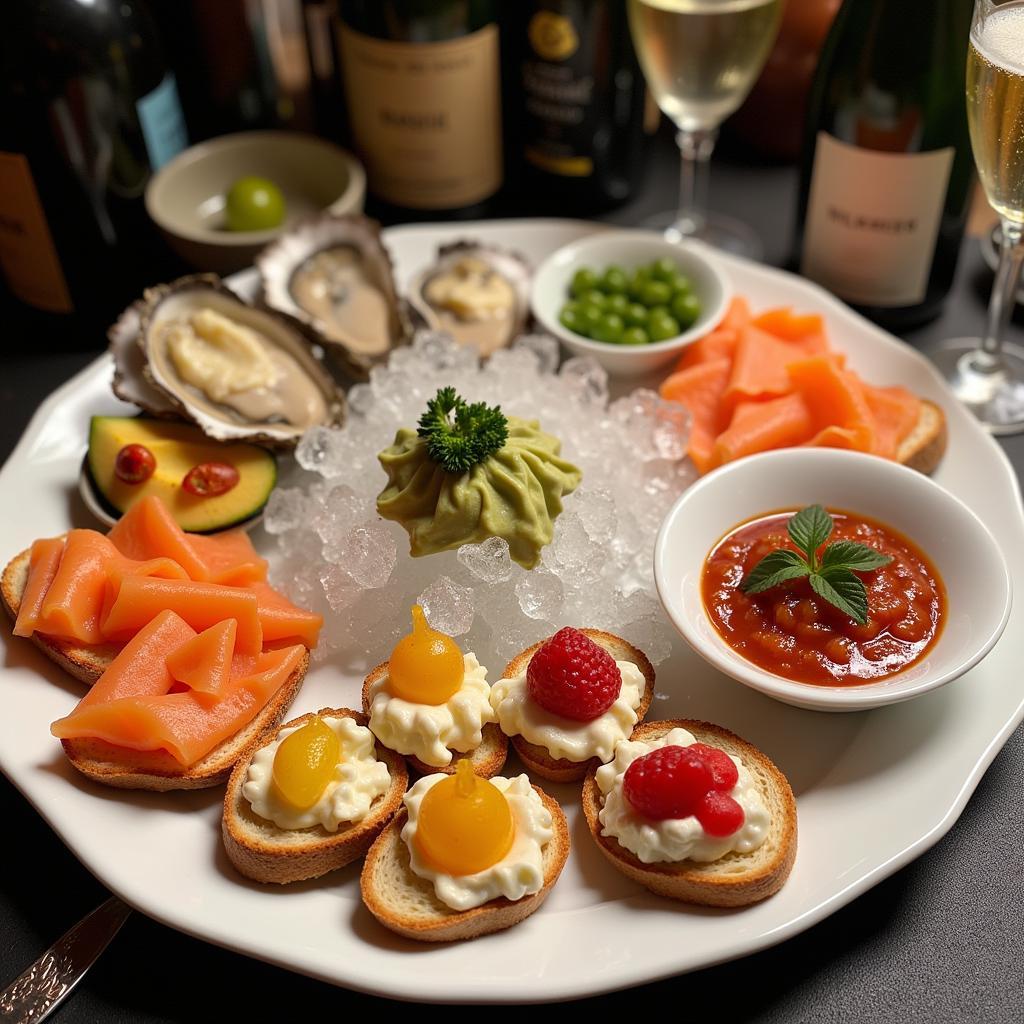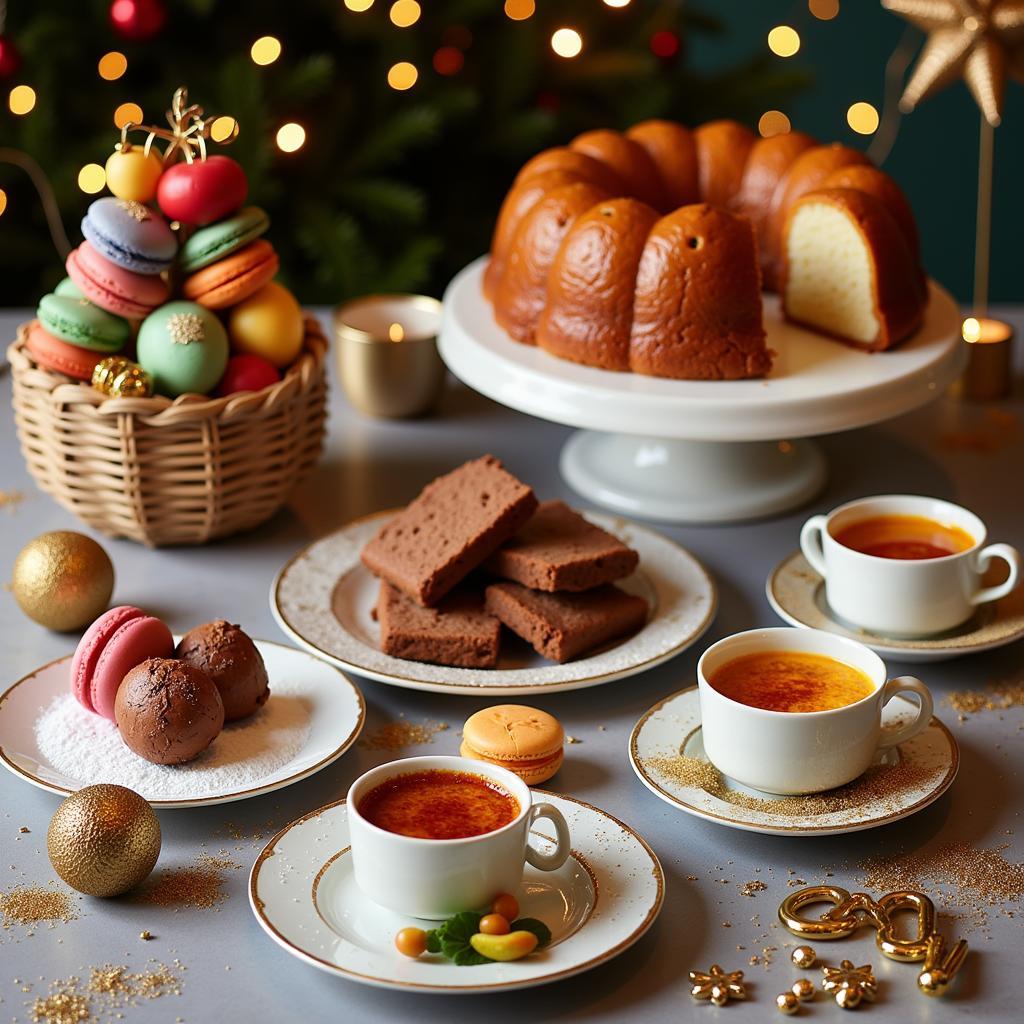French New Year’s Eve, or “le Réveillon de Saint-Sylvestre,” is a time for lavish celebrations and unforgettable feasts. Food plays a central role in French culture, and this special occasion is no exception. From elegant appetizers to decadent desserts, French New Year’s food is a symphony of flavors and traditions that promises to tantalize your taste buds and create lasting memories.
A Culinary Journey Through French New Year Traditions
The French New Year’s Eve feast is deeply rooted in symbolism and superstition. Each dish is carefully chosen for its auspicious meaning, believed to bring good luck, prosperity, and happiness in the coming year. Let’s delve into the heart of this culinary tradition and explore the significance behind some of the most popular dishes.
Appetizers: A Symphony of Flavors to Awaken the Palate
The festivities often begin with an array of elegant appetizers designed to whet the appetite. These bite-sized delicacies set the tone for the opulent meal to come.
- Foie gras: This luxurious delicacy, made from duck or goose liver, is a staple on many French New Year’s Eve tables. Its rich, buttery flavor is often paired with sweet accompaniments like fig jam or Sauternes wine.
- Oysters: Considered a symbol of prosperity and good fortune, oysters are another popular choice. Served fresh on the half shell with a squeeze of lemon juice, they offer a refreshing and elegant start to the meal.
- Smoked salmon: This delicate and flavorful fish is often served with blinis, crème fraîche, and a sprinkle of fresh dill. Its elegant presentation and refined taste make it a perfect appetizer for a special occasion.
 French New Year Appetizers Spread
French New Year Appetizers Spread
Main Courses: A Celebration of Abundance and Indulgence
The main course of a French New Year’s Eve meal is a true centerpiece, showcasing the finest ingredients and culinary techniques. From succulent roasts to delicate seafood dishes, the options are as diverse as they are delicious.
- Roast poultry: Roasted turkey, goose, or duck is a classic choice for the main course. These birds are typically stuffed with flavorful ingredients like herbs, chestnuts, or fruits, resulting in a moist and aromatic dish that embodies the spirit of celebration.
- Lobster: This luxurious crustacean is considered a symbol of good luck and abundance. Whether grilled, steamed, or baked, lobster adds a touch of elegance and sophistication to the New Year’s Eve feast.
- Beef Wellington: This impressive dish features a tender beef tenderloin coated in a savory mushroom duxelles and wrapped in golden-brown puff pastry. Its rich flavors and elegant presentation make it a truly celebratory main course.
Sides: Complementing the Feast with Elegance and Flavor
No French New Year’s Eve meal is complete without a selection of delectable side dishes. These culinary creations perfectly complement the main course, adding texture, flavor, and visual appeal to the feast.
- Truffle risotto: This creamy and aromatic risotto is infused with the earthy flavors of black truffles, creating a luxurious and indulgent side dish.
- Gratin dauphinois: Thinly sliced potatoes are layered with cream, garlic, and nutmeg, then baked to golden perfection. This classic French side dish is both comforting and elegant.
- Haricots verts amandine: These slender green beans are blanched and tossed in butter, toasted almonds, and a squeeze of lemon juice. Their vibrant color and delicate flavor provide a refreshing counterpoint to richer dishes.
Desserts: A Sweet Finale to a Memorable Meal
The sweet finale of a French New Year’s Eve feast is a symphony of flavors and textures designed to satisfy every sweet craving. From elegant pastries to decadent chocolate creations, these desserts are the perfect way to end the year on a high note.
- Bûche de Noël: This traditional Christmas log cake is often enjoyed throughout the holiday season, including New Year’s Eve. It’s made with a sponge cake rolled with a creamy filling and decorated to resemble a Yule log.
- Macarons: These delicate and colorful meringue-based cookies are filled with ganache, buttercream, or fruit preserves. Their elegant appearance and variety of flavors make them a festive and delightful dessert.
- Crème brûlée: This classic French dessert features a rich custard base topped with a layer of hardened caramelized sugar. Its smooth, creamy texture and contrasting flavors create a truly indulgent experience.
 French New Year Desserts Selection
French New Year Desserts Selection
Frequently Asked Questions about French New Year Food
What are some traditional drinks served on French New Year’s Eve?
Champagne is the quintessential drink for New Year’s Eve in France and around the world. Other popular choices include Kir Royale, a festive cocktail made with crème de cassis and Champagne, and red or white wine from various French regions.
What is the significance of the twelve grapes eaten at midnight?
Similar to the Spanish tradition, the French believe that eating twelve grapes at midnight, one for each stroke of the clock, brings good luck for the coming year.
Are there any specific foods to avoid on French New Year’s Eve for good luck?
Some superstitious French people avoid eating lobster or chicken on New Year’s Eve, as these animals are believed to symbolize backward movement or scratching in the dirt, potentially hindering progress in the New Year.
Embrace the Joie de Vivre of a French New Year
American food trivia might have its own charm, but experiencing a traditional French New Year’s Eve feast is an unforgettable culinary adventure. From the elegant appetizers to the decadent desserts, each dish is a testament to the French passion for good food, shared with loved ones in the spirit of celebration and good cheer.
Whether you’re planning an intimate gathering or a grand soirée, let the flavors of France transport you to a world of culinary delights. Embrace the “joie de vivre” and create lasting memories with a French New Year’s Eve feast that celebrates the art of fine dining and the joy of shared moments.
For assistance with crafting the perfect French New Year menu or to explore other culinary adventures, please don’t hesitate to contact us at Phone Number: 02437655121, Email: minacones@gmail.com, or visit us at 3PGH+8R9, ĐT70A, thôn Trung, Bắc Từ Liêm, Hà Nội, Việt Nam. Our dedicated team is available 24/7 to assist you.